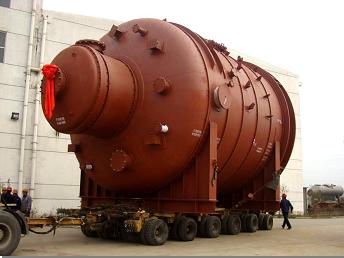
Photo by Sim Kih
Sunpower’s market cap of S$64 million does not put it on the radar screen of most fund managers, but the heat transfer specialist is establishing itself as a global name.
It trades at a PE ratio that does not reflect that, though.
As the executive chairman of Sunpower noted in an interview with NextInsight, companies similar to Sunpower are trading at as high as 60X PE in China. Sunpower trades at only 7.6X historical earnings according to Bloomberg, in comparison.
It is relatively unknown perhaps because it does not have peers listed on SGX.
Sunpower provides innovative solutions that save energy and protect the environment for heavy industries.
"Pressure vessel players usually specialize in research & development or in design & manufacturing, and we are the only global player which provides EPC services as well,” says its executive chairman and co-founder Dr Guo Hongxin, 45.
The soft-spoken scientist who speaks with scholastic charisma and a cherubic smile was in Singapore last week for Sunpower’s 1H09 results briefing.
He had insights for investors hoping to capitalize on beneficiaries of China’s fiscal stimulus for “green business”: While revenues of consumer businesses that promote environmental issues may do well, green businesses serving industrial companies have been hard hit by the widespread cut in budgets for capital investment last year.
His frankness about the state of the industry surprised me, since most CEOs go all out to persuade investors about the merits of one’s trade. However, despite the tough business environment, Sunpower has done well (more on the results shortly).

Sunpower provides EPC solutions that help industrial companies decrease operating expenses, and not merely diminish an intangible social ill. (For more on this, read SUNPOWER to benefit from China stimulus)
1H09 revenues had slipped 3% year-on-year to Rmb 268.9 million but net earnings grew 34% to reach Rmb 26.7 million. That works out to net margins of about 10%.
Net profits had been boosted by reversals of allowances for bad debts and impaired inventories.
Its order book currently amounts to Rmb 861 million.

From air conditioners, computer CPUs to oil refineries, heat transfer technology has a vital role.
About 55% of Sunpower's revenues come from making pressure vessels equipped with heat transfer technology, and these are mostly used in petrochemical factories, oil refineries, and steel mills.
China has issued about 20,000 licenses to makers of pressure vessels, but less than 10 are licensed to handle high-end pressure vessels made of precious metals and alloys involving the likes of titanium and zirconium.
Sunpower wants to be at the very pinnacle of the business of pressure vessels - those that are non-ferrous, corrosion resistant, and able to retain the purity of pharmaceuticals and LNG.

Another 38% of its revenues come from thermal pipes, again equipped with heat transfer technology, and related accessories.
It has earned industry reputation for high profile projects, such as the supply of thermal pipes for rail and highway infrastructure on the Qinghai-Tibet Plateau, one of the largest sub-arctic permafrost region on the planet.
Permafrost, or delicate frozen soil, blankets many parts of the region.
The construction of roads and railway there requires sophisticated expertise to ensure that the permafrost infrastructure foundation, as well as the ecological environment, remains stable and protected during winter and summer.
The company has filed 54 patents to date, and its innovativeness has contributed to high profile projects that were graced by inspection visits from top government officials, including Premier Wen Jiabao himself.
It is also one of only 6 pressure vessel and heat pipe makers qualified to supply to Chinese oil major, SINOPEC. The other 5 are SINOPEC subsidiaries.
About 3-4 years ago, it also began providing turnkey systems (EPC) for saving energy and environmental protection, which now contributes about 7% to group revenues.
EPC segment margins are current 10% to 15% compared to group margins of 29.6%. The management believes there is room for improvement in this segment as the company gains economies of scale.
|
Even though disappointed by Sunpower’s low valuation after listing in Singapore, Prof Guo assured investors that he has no intention to delist the company from the SGX. |
Look our for our next story on Tuesday (Aug 11), giving some personal insights into the chairman of Sunpower






